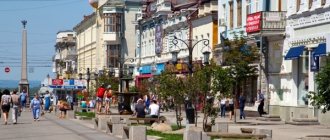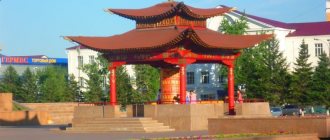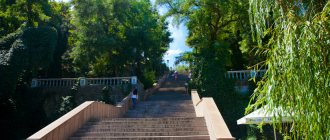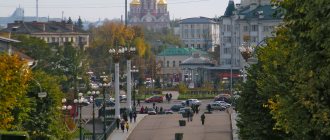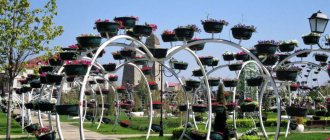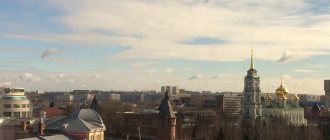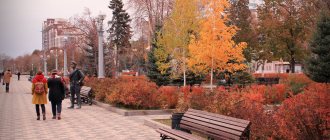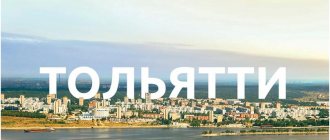Samara is one of the largest cities in Russia , ranking 9th in the country in terms of population (about 1,200,000 people). It is a well-known center of science, culture and industry, with a lot to see. In this article we will look at the main attractions of the city of Samara.
The city is located on the left bank of the main Russian waterway of the Volga, where the Samara River, which gave the city its name, and the Sok River flow into it. The climate here is temperate continental, the average temperature in January is -9.9°C, in July – +21.5°C. Samara has its own time zone, the difference with Moscow is 1 hour (1 hour more than in Moscow).
Historical reference
The founding date of the city is considered to be 1586 , although a certain pier with a settlement was noted in these places by the Venetians back in 1367. The first fortress was built by Prince Grigory Zasekin, according to the version for the Nogais who lived here to protect them from “dashing people”, but in fact , of course, to ensure the safety of trade routes between Kazan and Astrakhan.
The inhabitants of the fortress were initially “service people” who performed a security function. At the turn of the 17th – 18th centuries, as a result of fires, the fortress ceased to exist, and only in the anniversary year of 1986 a frame was made as an imitation of one of the towers, and a wall element with a memorial plaque.
From its very foundation, Samara was considered a city, in the 17th century. it was the center of the county, and at the end of the 19th century. - Samara province.
These places were not spared by peasant unrest in the 17th and 18th centuries. In 1670, Samara was captured by the soldiers of Stepan Razin, but when Emelyan Pugachev’s uprising began in 1773, Samara became the first city to go over to his side.
From 1929 to 1991 the city bore the name Kuibyshev . During the Great Patriotic War, it was here that the USSR government, a number of the most important departments and, of course, defense enterprises were evacuated. Stalin's move was expected, for which a special bunker was built.
Kuibyshev’s contribution to the victory over fascism is calculated in tens of thousands of aircraft built here, and a huge amount of weapons and ammunition produced at the city’s enterprises.
DEMOLISH CANNOT BE LEAVED
More recently, the landscape of the main street of old Samara has been enriched with a new monument. But today we will not talk about him, but about the well-forgotten old one. About those monuments that have been erased from the face of Samara by the inexorable pace of history.
MONUMENT TO ALEXANDER II
Sculptor - Vladimir Sherwood, opening date - 1889. Before the revolution it was the only monument in Samara. In addition to the emperor himself, 4 symbolic figures were added to the composition of the monument: a Russian peasant making the sign of the cross; Circassian breaking a saber; a Bulgarian woman thanking Alexander II for the liberation of her homeland, and a Central Asian woman throwing off her veil.
During the Civil War, the monument disappeared without a trace. In 1927, the leader of the world proletariat took the place of the emperor. Unlike Alexander II, who admired the Volga, Vladimir Ilyich looks towards Leningradskaya.
SCULPTURES OF LENIN AND STALIN NEAR THE OLD RIVER STATION
In 1936, a new comfortable river station was built in Samara, then Kuibyshev. It was located between the Leningradsky and Nekrasovsky descents, closer to the second. The departing citizens were seen off on their good journey not by anyone, but by the leaders themselves - Vladimir Ilyich and Joseph Vissarionovich.
During the fight against the latter’s personality cult, both sculptures were removed out of harm’s way, and in 1969, construction began on a new river station.
MONUMENT “STALIN AND LENIN IN GORKHI”
Let's not go far from the Volga. This is a typical monument that was installed at the Administration of the Volgotanker River Shipping Company on Maxim Gorky Street.
After the debunking of Stalin’s personality cult, he was kicked out of the shop. Vladimir Ilyich remained sitting on it alone, sadly peering into the distance. Rumor has it that some lonely people, exhausted by Narzan, sat down in the vacant seat in order to improve their health in the company of a cultured person. As a result, the monument was completely dismantled.
SCULPTURES OF WARRIORS NEAR THE OFFICERS' HOUSE
The pilot peers into the cloudless Samara sky. Maybe this is Valery Chkalov, after whom the descent to the Volga, a street, an alley and a village in the Kirovsky district are named in Samara. But this is unknown for certain, as is the year of dismantling of these sculptures.
Photo taken from Vladimir Samartsev’s book “Unprecedented Samara”
MONUMENT TO THE THIRD INTERNATIONAL
In a nutshell, the 3rd International is an international organization that united the world's communist parties and existed from 1919 to 1943. In Samara they decided to dedicate a monument to him. But the time was hungry and restless, and therefore the monument was not very large. He represented bent workers holding our blue ball on their muscular shoulders, like Atlases.
By 1932, the monument was almost completely destroyed and was dismantled without pity, and its place was taken by Vasily Chapaev and Co.
FIRST AND SECOND MONUMENTS TO PUSHKIN
We are talking, as you understand, about Pushkin Square. The Alexander Sergeevich who is standing there now is already the third in a row. The first one (pictured left) was installed in 1905, was made of plaster and stood until the mid-1930s. The second, already concrete, appeared here in 1949, and was dismantled for unknown reasons in 1962.
The third coming of Alexander Sergeevich to Pushkin Square occurred in 1985.
A MAN WITH A CHILD IN HIS HANDS
There were at least two copies of the typical Soviet sculpture in Kuibyshev. On the Agriculture Square (on the left) and near the old railway station building.
SCULPTURES OF WORKER AND RED ARMY MEMBER
Photo courtesy of Armen Arutyunov
They were guarding the entrance to the building of the Samara-Zlatoust Railway Administration. They were apparently dismantled during the “thaw” and replaced with flowerpots.
Unfortunately, it was not possible to find close-up photographs of these revolutionary guards, but from what is available, their silhouettes can be seen.
BUSTS OF SAMARA MERCHANTS
On the left is the unveiling of a bust of Anton Shikhobalov near the hospital he built on Sokolnichya Street. It took place in 1909. The construction of the hospital cost A. Shikhobalov 190 thousand rubles. Sokolnichya Street, on which it was located, was renamed Shikhobalovskaya and bore this name before the revolution. The current address of the hospital is st. Leninskaya, 75. It has been under reconstruction for many years, and it is unknown when it will be completed.
On the right is a bust of the merchant Yakov Sokolov next to the almshouse he built. By the way, bronze. Opened on August 21, 1911. The construction of the almshouse cost 200 thousand rubles. For comparison: the famous Kurlina mansion cost ten times less. The current address of the Sokolovskaya almshouse is st. Chkalova, 98. However, now it is not lonely elderly people who spend time there, but the escort department of the GUFSIN.
DOBRYNA AND THE SNAKE
An epic sculptural composition that previously adorned the fountain near the Skazka cafe in the village of Upravlencheskiy. Depicts the epic duel between the hero Dobrynya Nikitich and the filthy Serpent.
Attractions
A city with such a long and eventful history has many memorable and simply interesting places , but, like every city located on the banks of the Volga, first of all, it is proud of its embankment. And there is certainly a reason to be proud.
We will list the main attractions with photos, names and descriptions, but there are many more places in Samara that are worth visiting if you have enough time.
Embankment
It is the longest in Russia , stretching along the banks of the Volga for more than 5 km. At one time there were only berths for ships, warehouses and markets, but only in 1935 they decided to create a walking recreation area.
Near the water there are sandy beaches, especially popular in the summer heat, and above is the embankment itself.
It didn’t take long for it to become so beautiful and elegant, but today those walking along the tiled pavement will not only have the opportunity to admire the beauty of the river, but also many other impressions:
- the “Sail” fountain was created for the 400th anniversary of Samara, it has 620 jets, exactly as many cabin boys did not return from the Great Patriotic War;
- a monument to barge haulers , or rather, to the canvas of I.E. Repin “Barge Haulers on the Volga”, made in the form of a painting in a frame, where the background is a real river, was installed for the 170th anniversary of the birth of the artist who painted the famous canvas in the village. Shiryaevo, located near Samara;
- a monument to comrade Sukhov - the hero of “The White Sun of the Desert”, very similar to the artist A. Kuznetsov;
- The monument to the Navy cabin boys was placed here not by chance - more than 700 boys who graduated from the cabin boys school on the Solovetsky Islands went to defend their homeland from the River Station, 620 of them did not return;
- The “Cradle of Humankind” monument is very unique.
Helipad
One of the must-see places is the Helipad (Vertolyotka), located 18 km from Samara (Upravlenchesky village). From here you can enjoy extraordinary views of the Volga, Sokoly and Zhiguli Mountains, Zelenenky Island, the city itself and the right bank of the Volga, and all this, in fact, from a bird's eye view.
Once upon a time, forest was cut down here and rafted down the river, and when in the 30s of the last century they decided to build a hydroelectric power station, they built a village for the management - Upravlencheskiy. The construction was interrupted by the war, and after the war a plant was built to design engines (rocket and aircraft). The chief designer flew here by helicopter, so they called it “Helipad”.
Today it is an excellent vacation spot, where there is an observation deck, a restaurant, a square, and a parking lot. Celebrations are often held here, and newlyweds come to take photographs as souvenirs.
You can get here along Volzhskoye Highway. by car. On municipal transport it is more difficult, with transfers: bus No. 1, 45, 50, 78, 79, minibus No. 1, 1k, 113, 210 and others. Transfer to the village. Management at 1k or 210 to the stop. Branched, then 400 m on foot.
Stalin's bunker
This unique structure is surrounded by many legends . And indeed, the bunker was built in the strictest secrecy, because in the event of leaving Moscow at the beginning of the Great Patriotic War, Samara (Kuibyshev) became the reserve capital of the country, the Headquarters of the Supreme Commander-in-Chief would have to move to the Volga.
The facility was built behind a high fence for 9 months in 1942, 3,700 people took part in the work, including metro workers from Moscow and Kharkov, and miners from Donbass. Everyone signed a non-disclosure agreement, did not leave the fenced area, and the soil was removed at night.
Stalin's bunker is one of the largest structures of this type in the world . Its depth is 37 m (Hitler's bunker, for comparison, is 16 m deep). It was declassified only in 1990. One of the legends says that Stalin visited here, because. his daughter lived nearby in evacuation. There is no exact answer. There is also a legend that all the builders were shot, which is also not confirmed.
Today, the main rooms of the bunker are open to visitors - Stalin’s room and the government meeting room. Their decoration and furnishings, and, of course, the most interesting excursion leave a great impression. Tours are by appointment only.
Museum address: st. Frunze, 167, open Mon.–Fri. from 11:00 to 15:00, lunch from 13:00 to 14:00.
House with elephants
There is an amazing house in Samara, which is popularly called the “House with Elephants”. This is the dacha of merchant K. Golovkin , built in Art Nouveau style in 1909. Its owner was a successful merchant, philanthropist, and a good artist. He founded the art department at the Samara Museum, and after the revolution he was engaged in museum activities.
The owner himself participated in the creation of the project and decoration of the premises of the building. He was also the author of sketches of famous elephants.
Unfortunately, the turbulent history of the house (hospital - kindergarten - club) has left its traces, and today the dilapidated but still beautiful building is awaiting restoration and the beginning of a new life.
House address: st. Soviet Army, 296.
Von Vacano Mansion
The creator of the famous Zhiguli beer was the Austrian nobleman Alfred von Vacano, a resident of Samara. In 1914, a mansion was built for him in the German Art Nouveau style (“Jugendstil”), architect D. Werner.
The building fits perfectly into the ensemble of Theater Square. Unfortunately, the owner was accused of espionage in 1915.
Alternately, a Red Army club and even communal apartments were located here, today a state institution . The building has been restored and is protected by the state.
Address: Shostakovich street, 3.
Temple of the Heart of Jesus
The Catholic church was built in 1906 in the neo-Gothic style . It was decorated very richly, and organ music accompanied the services. In the 20s of the last century it was closed and alternately used as a cinema, technical school, anti-religious and local history museum.
Today the church was returned to the Diocese, restored, the altar fresco here is a copy of a painting by Salvador Dali, and this is the pride of the temple. A new organ was brought from Austria. The temple is open to visitors and you can take a free tour.
Address: st. Frunze, 157.
Monument to V.I. Chapaev
In 1932, at the place where 12 Red Army soldiers were buried, the most expressive monument of Samara was erected - the monument to V.I. Chapaev. It decorates the square in front of the drama theater .
The sculptural group consists of 8 people, where, in addition to the heroic commander on a war horse, a woman with a rifle and a sailor-machine gunner, a commissar, a soldier, and a peasant are represented.
The height of the monument is 17 meters, the base is 22 meters. The composition was made in Leningrad.
Address: Shostakovich street, 3.
Art Museum
One of the largest provincial museums in Russia. The building from the early 20th century is an architectural monument . Exists since 1897. Its collection is constantly growing, and currently includes over 35,000 exhibits dating from the 16th to the 21st centuries, including works by I. Aivazovsky, K. Bryullov, A. Kuindzhi, K. Malevich and others.
The museum is open to visitors every day except Tuesday, from 10:00 to 18:00, on Thursday from 13:00 to 21:00.
Ticket prices range from 40 to 120 rubles , there are preferential categories of citizens. Address: st. Kuibysheva, 92.
Estate of A.N. Tolstoy
The author of “Pinocchio” and “Peter I” is the red count A.N. Tolstoy was born in the Samara province in 1893, his father was the mayor of Samara. Since 1898, the writer lived in Samara , where the family purchased a house, the current address of which is st. Frunze 155.
The building was built in 1882 - 83. Since 1983, there has been a literary museum , where the archives of A.N. are collected. Tolstoy and his mother, the writer A. Bostrom, but the apartment where they lived has also been restored, which allows you to plunge into the life of a provincial city at the end of the 19th century.
The museum is open seven days a week from 9:00 to 17:30. Ticket prices range from 70 to 150 rubles.
Kuibyshev Square
The Kuibyshev area is rightfully considered the largest in Europe (17.4 hectares). This is not only the venue for all public events in the city, but also a recreational area. At the corners of the square there are beautiful squares with benches.
On this territory there is a monument to V. Kuibyshev and the Samara Opera and Ballet Theater, which was renovated several years ago. The theater amazes with its beauty and sophistication.
Train Station
Samara railway station is called by many one of the most beautiful in Russia. Indeed, the architectural and color scheme of the building is amazing. On the second floor you can visit the Kuibyshev Railway Museum, and at an altitude of 95 meters an observation deck is available for tourists.
Iversky Monastery
The history of the monastery dates back to 1850. In 1925 it was closed, and only in 1992 it resumed its activities. On the territory of the monastery there is a cemetery where eminent residents of the city, for example, Peter Alabin, are buried.
Drama theatre
The theater is named after A.M. Gorky , has existed since 1851. The modern building in 1888 is in pseudo-Russian style, for which local residents call it “teremko”. In 1901, plays by A.M. were staged on this stage for the first time. Gorky. Today the theater has a rich, varied repertoire and a worthy troupe. Stars from both capitals often come on tour.
The large and beautiful city of Samara is rich in attractions. There are monuments and temples, museums and theaters, monasteries and pretty mansions from the beginning of the last century.
And also such amazing monuments as:
- monument to the battery (heating);
- Internet monument;
- monument to a tram car;
- a smoking crocodile and much more, important or not very important, serious or playful, but always done with soul for the joy of people.
We can only wish you good excursions around Samara, because now you know what natural and historical attractions this city has.
Cultural guide to Samara
Museum and exhibition
Samara
Despite the fact that the Museum and Exhibition Museum is one of the youngest museums in the city, which opened on April 12, 2001, it has managed to become a must-see destination on tourist routes.
It is impossible not to notice the building of the center. On its façade there is a real Soyuz rocket, 68 meters high. This is the only vertically mounted launch vehicle in Europe in assembled form. On the ground floor of the museum there is an exhibition dedicated to the technical equipment of orbital stations, the design of spacecraft and instruments. The next part of the exhibition tells about the daily life of astronauts at the orbital station.
Samara Literary and Memorial Museum named after. M. Gorky
Samara
Literary and Memorial Museum named after. Gorky opened in 1941 in a house on Razin Street (now Frunze Street), where the writer lived. And while studying at the Samara real school, another future writer, Alexei Tolstoy, lived in this house. And it just so happened that most of the exhibitions at the Gorky Museum are dedicated to Alexei Tolstoy.
The furnishings in the writer's memorial apartment recreate the atmosphere of provincial life at the beginning of the last century. Here you can see letters and documents from relatives of Alexei Tolstoy; Antique furniture and other interior items have been preserved.
Museum of Art Nouveau. Mansion A.P. Kurlina
Samara
The Art Nouveau Museum is located in the Kurlina mansion. The mansion was built in 1903 by the merchant of the first guild Kurlin and became one of the first buildings in the Art Nouveau style in Samara.
The museum recreates the atmosphere of the late 19th - early 20th centuries. It was during this period that merchant Samara flourished. The house project was created by architect Alexander Zelenko.
The visitor will also notice the centricity characteristic of Art Nouveau: for example, all the rooms on the first main floor are grouped around the hall. Each of the 22 rooms of the house has its own artistic image. Thus, the dining room is made in an antique style: the ceiling beams are decorated with stucco with images of deities, and the wall tiles are decorated with mythical creatures; the living room is stylized as the Middle Ages.
Samara Academic Drama Theater named after. M. Gorky
Samara
In Samara there is the oldest provincial theater in Russia - the Samara Academic Drama Theater named after. M. Gorky. The first theater troupe began its work back in 1851, with the production of Gogol's The Inspector General. During the Soviet years, the theater was called the Kuibyshev Gorky Drama Theater; in 1977 it became an academic theater.
Today the theater actively tours, films television versions of performances, participates in numerous festivals and itself is their organizer.
House-Museum of V.I. Lenin
Samara
On Leninskaya Street in Samara there is a branch of the Samara Regional Museum of History and Local Lore named after. Alabina – House-Museum of V.I. Lenin. The historical monument of federal significance is located on the territory of a city estate of the late 19th century, preserved almost in its original form.
The house belonged to the Samara merchant Ilya Rytikov, from whom the Ulyanov family rented housing. It was during this period, 1890–1893, that Vladimir Lenin’s worldview was formed, he wrote his first theoretical works and created a Marxist circle.
The house became a museum in 1940, and for Lenin’s centenary in 1970, an exhibition dedicated to the Samara period of his life was organized on the ground floor. On the second floor, the household furnishings of the Ulyanovs’ apartment were reconstructed. Later, during the restoration work, museum services were moved to a neighboring house, connected to Rytikov’s house by an underground passage. This is how a small museum complex was formed.
Cultural and exhibition city Samara
Samara
The cultural and exhibition center opened in Samara in March 1998. You can visit exhibition halls dedicated to ancient civilizations, world painting and see a collection of minerals completely free of charge. Masterpieces of world painting are presented at the Center with digital copies of paintings by Russian and foreign artists. The center operates a photo agency whose task is to photograph picturesque places in Russia and other countries for photo panoramas and photo exhibitions.
House-Museum of M.V. Frunze
Samara
House-Museum named after. M.V. Frunze in Samara opened on February 23, 1934. The museum building was built in 1891, and currently it is a monument of residential architecture.
The museum has three permanent exhibitions. The last of them invites visitors to see materials from 1918–1920, previously hidden under the heading of secrecy. Here you can learn about the confrontation between the armies of Frunze and Kolchak on the Eastern Front, about the anti-Soviet uprising in the rear of the Eastern Front, about desertion in the Red and White Armies and other events during the Civil War.
